A while back Tucker Stone and I blogged our way through a volume of Bob Haney’s The Brave and the Bold. We called the series The Cowardly and the Castrated because back then we were just wee little girlie bloggers, and the other bloggers made fun of us, yes, even Matthew Brady and Jog. They wiped eye-snot on our Hal Jordan ofrendas and made us ingest our entire painstakingly obtained collection of Alan Moore beard clippings — which had to be even more painstakingly and even humiliatingly retrieved with the use of a powerful magnifying glass, forceps, and twenty pounds of prunes.
But that’s all in the PAST!! Our sinews are new, our nether orifice is rectilinear, our hit counts are UP, and we are ready to ask that immortal question (without even a slight pause to ponce): WHOM IS YOUR DADDY!
Savage Tales #1
Writer: Gerry Conway and Roy Thomas
Artist Gray Morrow
1971
So with a name like Man-Thing, you shouldn’t be surprised when you get some action. Still, even Peter Wood or Randy North would have to be impressed at how fast we’re into the muck here. Sure, there’s a little three-page tease where we’ve got the big fella wrestling with an alligator (not that that isn’t kind of hot in itself) but then we’re right, right there:
Yep. You can tell she’s bad ’cause you can see her bits; you can tell he’s a cad ’cause he’s got hair on his tits. And thus endeth my rap career. But you get the point; sure, it’s the 70s and all, but no girl like that is gonna wear some abbreviated piece of ephemera and throw herself at a guy with +5 body foliage and galloping neuroses unless she plans to be holding a cigarette and selling his secret formula to the plug-uglies within a page or two.
Oooh, why that….ooooh! She just totally castrated him! Darn femme fatale. But no worries! He will regain his manhood by injecting the super-soldier formula he has stolen from Captain America!
And, presto! It works! Up from the depths he comes (as it were), and his nose is way, way bigger than her cigarette. Those manipulative pretty girls, getting into car crashes and falling out of their clothes just to tease us! Well let’s see how they like a little rape fantasy, huh?
Stupid good looks; that’s what let’s them control us, huh guys? But we’ve had our way with her now, and she’ll never rob another man of his precious fluids.
And afterwards, as the caption sententiously wonders, “Why did you feel …soft towards her at that last moment?” Why indeed? Don’t worry, though…you just need a minute or two and I’m sure you’ll be ready to go again. And soon, as your consciousness fades away utterly, you need never be soft again; like Jason in Friday the 13th, losing your mind and your manhood makes you paradoxically more masculine. It takes a thing to be a man.
That’s the last panel of our Man-Thing tale, and it’s really nicely done; you can see the poignant confusion in those beady little eyes. Man-Thing is the phallus, but he’s also a wounded child…which emphasizes again just how much he is the law. The law inhabits bodies which are mockeries, because all bodies are mockeries before the law—which is why defacement is such a perfect punishment.
I mentioned off-hand the way this origin mirrors Captain America’s; I think they even use the phrase “Super-soldier formula” a couple of times. One of the things Stan Lee did at Marvel was to figure out how seamlessly the the horror genre and the super-hero genre could fit together. The Thing, the Hulk, Man-Thing; all suggestively named shambling shibboleths; castrated weaklings whose naughty severed portions rise up and walk and start kicking ass and taking names. Whether the big needle turns you into an upright American or a giant veiny monolith, it’s really, in some sense, all one and the same. Male Freudian fantasy is male Freudian fantasy. Yes, Captain America is a more straightforward dream of power, good against evil, whereas Man-Thing passes through masochism and self-pity in order to justify seizing the phallus and wreaking havoc. But we’re still talking about bifurcated selves; weaklings feeling a prick before transforming into the vengeful law.
Gray Morrow’s art is great, by the way. Trusty Wikipedia says it was originally in black and white, which is certainly what it looks like; the grey washes are nicely done (though we may be losing a little detail in the reprinting? It’s kind of muddy — not that that’s not appropriate in some sense.) He draws some fine, basic cheesecake and good drippy tactile vines. Nice pacing and clean, imaginative layouts, too:
I like the way the last inset panel breaks up the bigger shot of Man-Thing against the moon; it makes the sky seem to stretch up and up, isolating our muck monster dramatially.
Oh, and if you’re wondering which came first, the scientist falling into swamp with secret formula who turned into Man-Thing or the scientist falling into swamp who turned into Swamp Thing…it was Man-Thing. Roy Thomas and Len Wein were roommates at the time, and Wein seems to have more or less shamelessly ripped off Man-Thing for Swampy. Or so says Wikipedia, anyway. That’s why, in later issues, we learn that Man-Thing can only burn you if you feel fear or have downloaded copyrighted material in the last 24 hours.
Astonishing Tales #12
Writer: Roy Thomas and Len Wein
Pencillers: John Buscema and Neal Adams
Inkers: Dan Adkins and Neal Adams
1972
Astonishing Tales #13
Writer: Roy Thomas
Pencillers: John Buscema and Rich Buckler
Inker: Dan Adkins
1972
That first Swamp Thing tale [Update: I mean Man-Thing of course, darn it] had an elegance that I associate with good exploitation fare — rape-revenge stories or slasher films, where the formula has the iron inevitability of a folk tale. These Astonishing Tales stories are from only a year later, but elegant they ain’t. Most of the two-parter is basically a Kazar story with decent art by John Buscema, and Roy Thomas basically writing whatever pops into his head — Kazar fights security guards in an airport? Sure! Sabre-toothed tiger vs. alligator? Why not! Just so long as Kazar can keep referring to himself in the third person, it’s all good. Highlight quote: “Ka-Zar is strangely appeased by this thing you call…gumbo.” No, really. It’s in there, I swear. Other favorite moments are the revelation that Shield asked one of its top scientists to pimp herself out in order to uncover an AIM spy. Keeping it classy guys.
The Man-Thing on Ka-Zar action is fairly entertaining as well:
This is the moment where we figure out that the Man-Thing is attracted to/burns up anyone who feels fear. In this sequence,, it’s fairly clear that fear has gendered implications. Those who fear are emasculated, and so Man-Thing can destroy them — the first burning in issue #1 was an obvious rape, and his later assaults are also, I think, rape-like. But once Ka-Zar decides to man up, the gender dynamics switch, and we get a super-hero/super-villain fight, where the homoerotic tensions are worked out through violence rather than through violation. (I know Ka-Zar isn’t quite a super-hero officially…but I feel bad for him. It’s okay, Ka-Zar. Wearing no shirt, wearing tights; it’s all good.)
Where was I? Oh yeah. I know I claimed above that super-heroes and horror were effectively the same, but perhaps I spoke too soon. Because trying to squish Man-Thing and Ka-Zar into one big savage ball of fun does point up some of the genre differences. Most obviously, (as I did suggest above) horror tends to embrace masochism less equivocally. When Ka-Zar first confronts Man-Thing, he’s behaving like he’s in a horror storyline; he’s scared and about to be victimized. The catharsis is in identifying with his fear and anticipating his defeat. But then he remembers that he’s a super-hero, damn it…and he’s back to battling the villain in grand manner, even if he’s tightsless. There’s something of the slasher movie switch, where the final girl gets to battle back against the slasher and eventually overcome him…but it happens too fast, here, and Ka-Zar is too all-fired competent. Basically, in slasher films, the payoff is in the fear, the vulnerability,and the triumphant reversal of roles. In super-hero action, the payoff is in never really being in danger; the invulnerability. The Man-Thing/Ka-Zar battle flirst with the one, then with the other, and ends up confused. It’s an interesting confusion though; you don’t usually get to see super-heroes lose their shit the way Ka-Zar does for a second here.
The real centerpiece of the storyline, though is a seven page feature written a year earlier (again, says Wikipedia) by Roy Thomas and drawn by Neal Adams. It’s dropped into the narrative wholesale, as a flashback. Thomas seems a lot more focused in these older pages, the 2nd person narration is completely over-the-top, “You shambled along silently — struggling to pierce the cobwebs cloaking your mind –where did you know the old woman from?” It’s so incessant and so purple that it ends up sounding definitely mocking; like we’re supposed to be laughing at the fact that this scientist has been reduced to a mentally deficient shambling mound of sludge. It’s also, as a stand alone story, significantly more brutal; Man-Thing kills a bunch of people in an effort to protect the scientist who may be able to help him…and then she gets pointlessly and viciously killed. (They claim she’s just in a coma for the latter story, but I’m pretty sure she was originally headed to the grave.) Neal Adams’ art is also more explicitly exploitative than John Buscema’s, in several senses; his violence is a lot more visceral:
And his cheesecake is more toothsome.
All in all, these seven pages are more of a piece with the first story; they’re mean-spirited horror rather than triumphant action-adventure. Unfortunately, the reproduction is also, as you can see, for shit. Not sure why this should be; it was originally printed in black and white, but it just looks like we’re losing a ton of detail. A real shame.
Fear #10
Writer: Gerry Conway
Artists: Gray Morrow and Howard Chaykin
1972
Wikipedia says that Chaykin did the pencils here and that Morrow is the inker. In any case, the art is very nice…and the storytelling is much smoother than in the Ka-Zar clunkfest. Even the omnipresent voice-over has been pared away, and instead we get silent cinematic sequences like this:
Unfortunately, while the execution is improved, the narrative itself is hard to get behind. That baby that Man-Thing catches was dropped by some abusive hick who hates the kid because it comes between him and his improbably hot wife, Billie-Jo. After looking deep into the baby’s eyes, Man-Thing feels the psychic connection, and becomes his infantile avatar. He hunts Daddy down, reduces him to whiny terror in satisfying Oedipal fashion, and then burns his face. And then…a miracle occurs! Now that the big bad patriarch has been castrated, his wife loves him again,— and being punished has also, we are told, “somehow awakened the surviving humanity” in his soul. Awww.
The fantasy of dad disciplined and domestic harmony restored could work in some circumstances; it’s how Jane Eyre gets resolved, more or less. There’s a magical, fairy-tale, day-dream logic to it — the child’s wish to become powerful and make Mom and Dad love each other again.
The problem is…well, I keep thinking about what would happen if this were Friday the 13th, right? If Man-Thing were Jason, he might well stumble on the same backwoods husband and wife duo, staples of horror genre exploitation that they are. And when Jason found them…he’d slaughter them! And that would be the right thing to do, because they’re insufferably irritating white trash caricatures, with his neanderthal assholery and her ineffectual whining and their mutual dysfunctional relationship. I don’t want them to make it up and become better people because (A) I don’t believe for a second that they would do that in the first place, and (B) they’re so clearly idiotic stereotypes that it insults my intelligence to pretend that they can achieve salvation through any method other than the scythe. Basically, it feels like the creative team here is trying to turn horror into sentimental fantasy romance, and you can hear the gears grinding.
So far, then, we got one quite decent straight horror tale, one clumsy but somewhat entertaining effort to fuse horror and super-heroic action, and one smoother but ultimately more annoying effort to fuse horror with melodrama. I’m not sure how Steve Gerber is going to rescue this exactly, but I hope he finds a way; there’s a big book left, and if I have to keep reading stories like that last one, I’m going to be pretty cantankerous by the time we’re done.
Update: More Man-Thing blogging tomorrow at The Factual Opinion by Tucker, then back here on Wednesday.
Update 2: And Tucker’s follow-up post is now online.

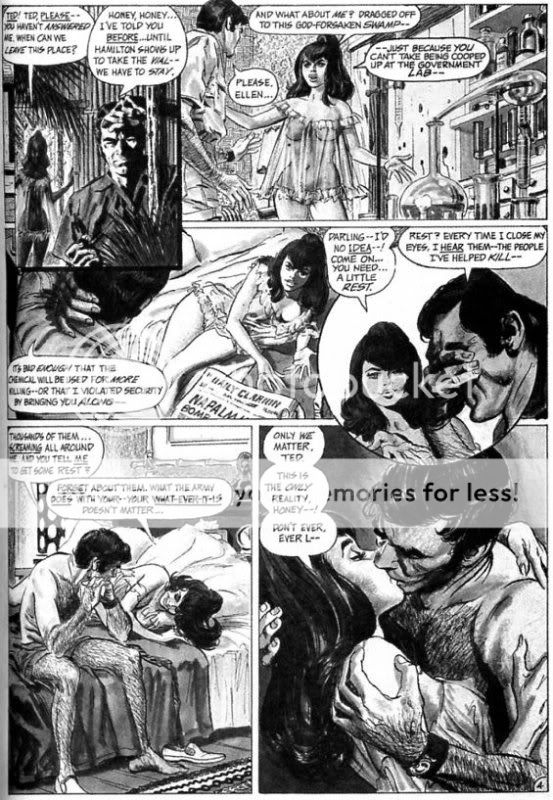

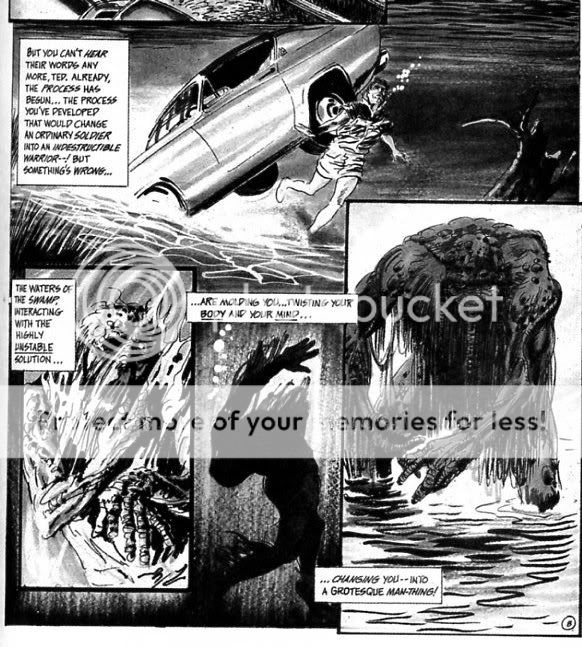


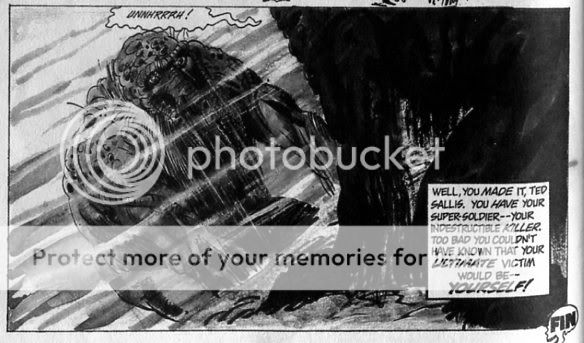
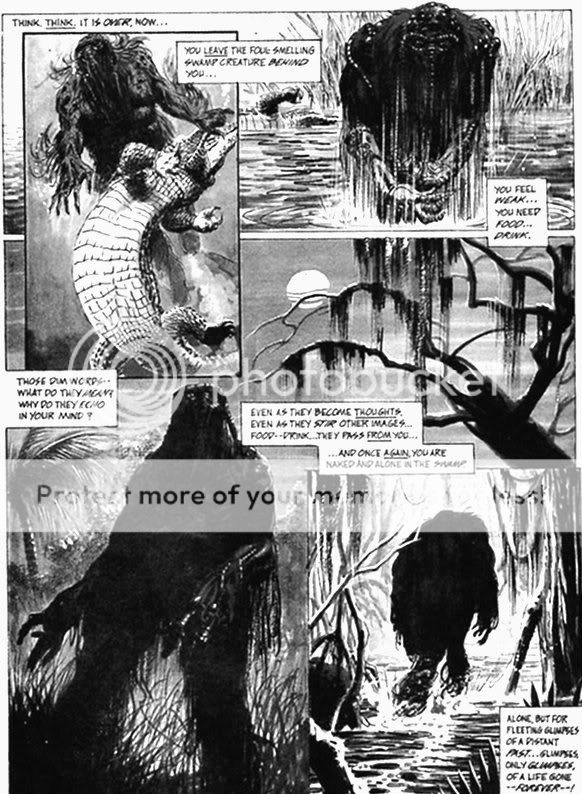
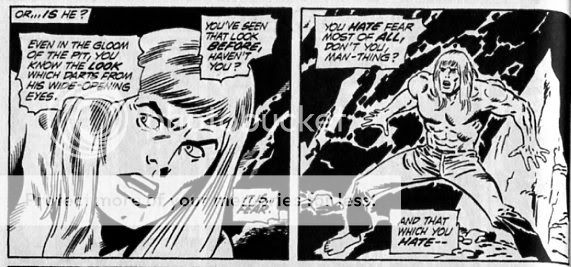

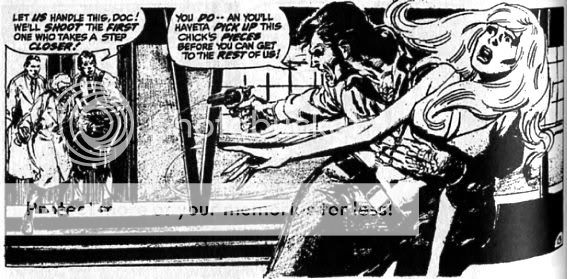
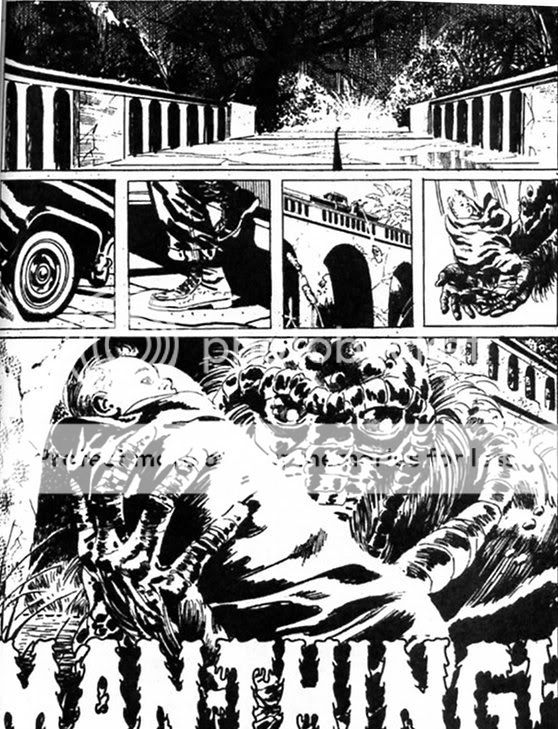
Is Man-Thing always written in the second person?
Roy Thomas likes to write the voice-over in 2nd person. Steve Gerber pretty much abandons it, though.
I’m sadly disillusioned by the fact that Man-Thing came before Swamp Thing. For some reason, I thought the reverse. (It was kind of funny when you called MT ST in the post though–I mean, they are basically indistinguishable). That’s some pretty good art though…in the first story.
Dagnabit! I knew that was going to happen.
well, moving in to the Fear series certainly should provide plenty of fodder for examination here. Gerber was one to play fast and loose with the ’70’s marvel formula, and while it doesn’t always work, when it does, ti way transcends the modiocre stories of the same period.
The Neal Adams material here is typical for the time period – Neal would be using markers or some such and hving the repo be poor while poor gray was slaving away iwth gouache and ink washes. It also points out the changes in storytelling here. On the neal panel, the violence is more graphic, which neal could do so well since he understood the structure, yet the caption, with large word “violence” leading the eye into the punch is just the sort of annoying storytelling that drives me nuts.
I may have to blog along with you guys on this one, since I really dig those man thing books.
charles
Hey Charles. Good point about the “violence”; I hadn’t even really processed that, but it is kind of silly.
I’m wondering what Tucker will think about Gerber. I’m underwhelmed so far, though there are a couple of interesting touches….
I actually have this book, and I’m glad that I can read along with you guys for once!
The main problem I have is that Man-Thing is such a limited character-we don’t get much emotion or dialogue from him (it?).
I have faith in Gerber, though. He’s the reason I picked this up.
The Neal Adams sequence in Astonishing Tales #12 was written by Len Wein and intended for the second issue of Savage Tales (the one intended to come out soon after the Savage Tales #1; not the second issue that came out a couple of years later, containing the Roy Thomas/Barry Smith adaptation of “Red Nails”).
Ah, good to know. Thanks Jeff.